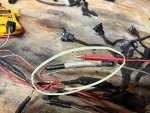JerrySab
Well-Known Member
- Joined
- Jul 11, 2020
- Messages
- 217
- Age
- 44
- City
- Los Angeles
- Vehicle Year
- 1988
- Engine
- 2.9 V6
- Transmission
- Automatic
Hey gang!
This may belong in electrical, but starting here as it may be engine specific.
I’m taking the opportunity to comb through the wiring while the engine is still out, and found the ground wire for my Idle control valve to have 1.3-6 ohms from pigtail to connector.
which is kind of a smoking gun to me, but wanted to confirm that there isn’t a resistor in this rubber sleeve.
also, what is this sleeve? Is it like an inline fuse?
thanks
This may belong in electrical, but starting here as it may be engine specific.
I’m taking the opportunity to comb through the wiring while the engine is still out, and found the ground wire for my Idle control valve to have 1.3-6 ohms from pigtail to connector.
which is kind of a smoking gun to me, but wanted to confirm that there isn’t a resistor in this rubber sleeve.
also, what is this sleeve? Is it like an inline fuse?
thanks














